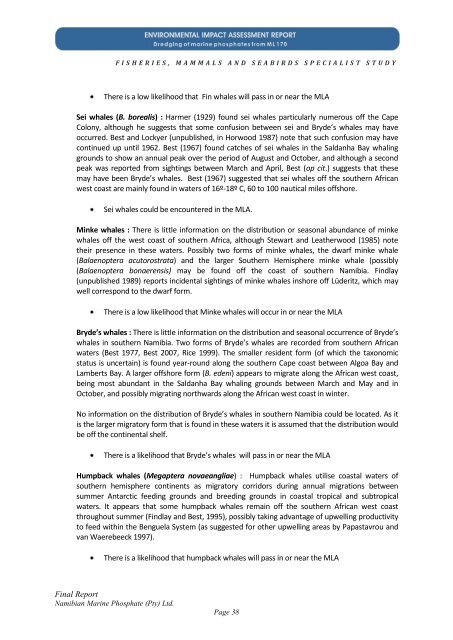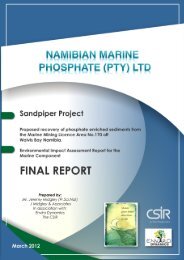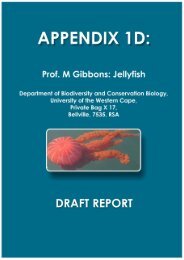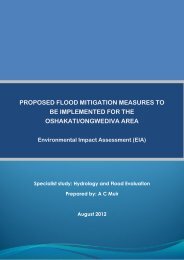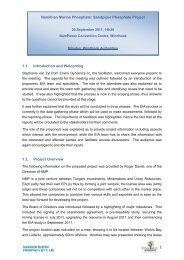Fisheries - Enviro Dynamics Namibia
Fisheries - Enviro Dynamics Namibia
Fisheries - Enviro Dynamics Namibia
Create successful ePaper yourself
Turn your PDF publications into a flip-book with our unique Google optimized e-Paper software.
F I S H E R I E S , M A M M A L S A N D S E A B I R D S S P E C I A L I S T S T U D Y<br />
There is a low likelihood that Fin whales will pass in or near the MLA<br />
Sei whales (B. borealis) : Harmer (1929) found sei whales particularly numerous off the Cape<br />
Colony, although he suggests that some confusion between sei and Bryde’s whales may have<br />
occurred. Best and Lockyer (unpublished, in Horwood 1987) note that such confusion may have<br />
continued up until 1962. Best (1967) found catches of sei whales in the Saldanha Bay whaling<br />
grounds to show an annual peak over the period of August and October, and although a second<br />
peak was reported from sightings between March and April, Best (op cit.) suggests that these<br />
may have been Bryde’s whales. Best (1967) suggested that sei whales off the southern African<br />
west coast are mainly found in waters of 16º-18º C, 60 to 100 nautical miles offshore.<br />
Sei whales could be encountered in the MLA.<br />
Minke whales : There is little information on the distribution or seasonal abundance of minke<br />
whales off the west coast of southern Africa, although Stewart and Leatherwood (1985) note<br />
their presence in these waters. Possibly two forms of minke whales, the dwarf minke whale<br />
(Balaenoptera acutorostrata) and the larger Southern Hemisphere minke whale (possibly<br />
(Balaenoptera bonaerensis) may be found off the coast of southern <strong>Namibia</strong>. Findlay<br />
(unpublished 1989) reports incidental sightings of minke whales inshore off Lüderitz, which may<br />
well correspond to the dwarf form.<br />
There is a low likelihood that Minke whales will occur in or near the MLA<br />
Bryde’s whales : There is little information on the distribution and seasonal occurrence of Bryde’s<br />
whales in southern <strong>Namibia</strong>. Two forms of Bryde’s whales are recorded from southern African<br />
waters (Best 1977, Best 2007, Rice 1999). The smaller resident form (of which the taxonomic<br />
status is uncertain) is found year-round along the southern Cape coast between Algoa Bay and<br />
Lamberts Bay. A larger offshore form (B. edeni) appears to migrate along the African west coast,<br />
being most abundant in the Saldanha Bay whaling grounds between March and May and in<br />
October, and possibly migrating northwards along the African west coast in winter.<br />
No information on the distribution of Bryde’s whales in southern <strong>Namibia</strong> could be located. As it<br />
is the larger migratory form that is found in these waters it is assumed that the distribution would<br />
be off the continental shelf.<br />
There is a likelihood that Bryde’s whales will pass in or near the MLA<br />
Humpback whales (Megaptera novaeangliae) : Humpback whales utilise coastal waters of<br />
southern hemisphere continents as migratory corridors during annual migrations between<br />
summer Antarctic feeding grounds and breeding grounds in coastal tropical and subtropical<br />
waters. It appears that some humpback whales remain off the southern African west coast<br />
throughout summer (Findlay and Best, 1995), possibly taking advantage of upwelling productivity<br />
to feed within the Benguela System (as suggested for other upwelling areas by Papastavrou and<br />
van Waerebeeck 1997).<br />
There is a likelihood that humpback whales will pass in or near the MLA<br />
Final Report<br />
<strong>Namibia</strong>n Marine Phosphate (Pty) Ltd.<br />
Page 38


